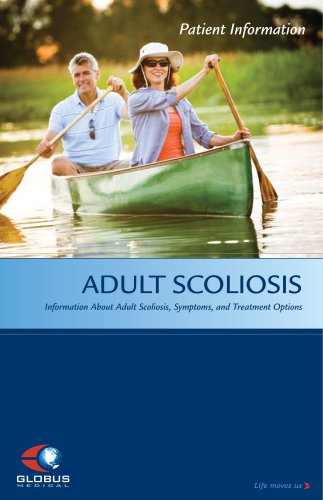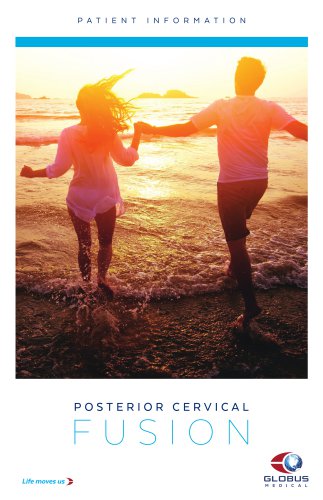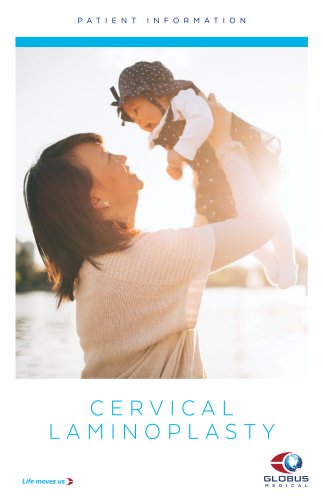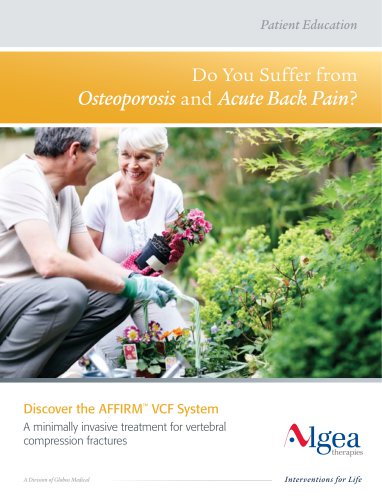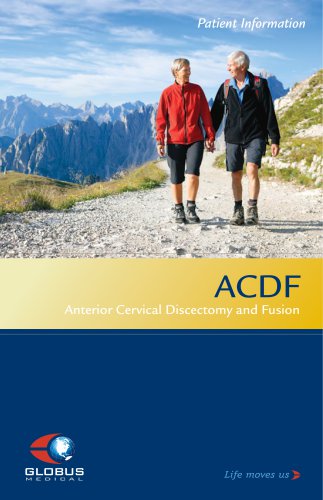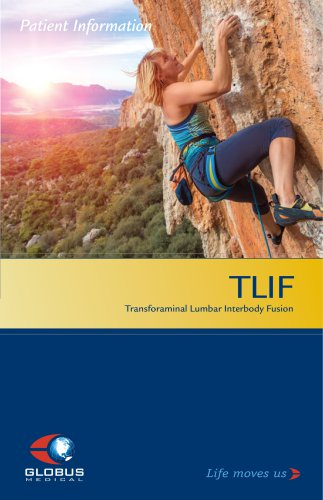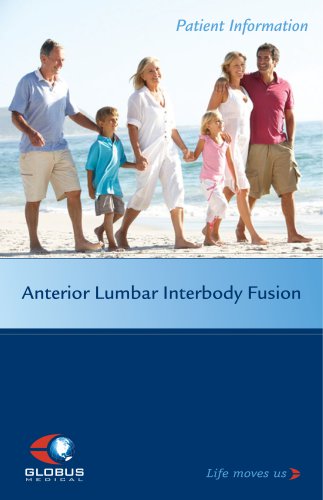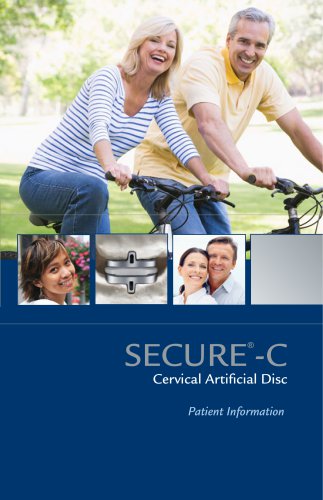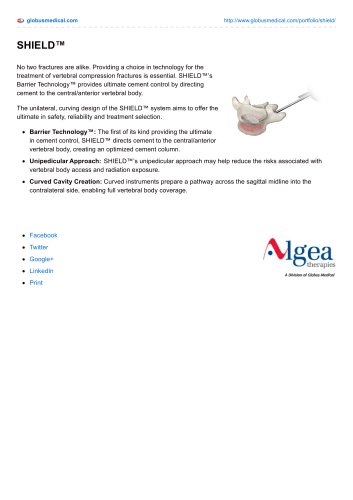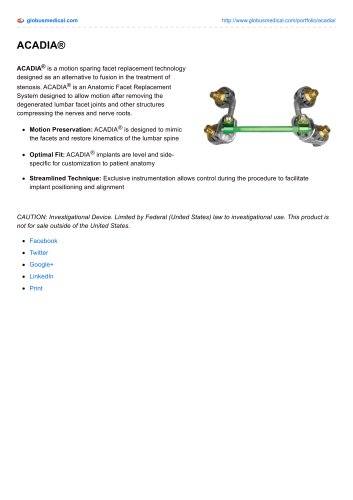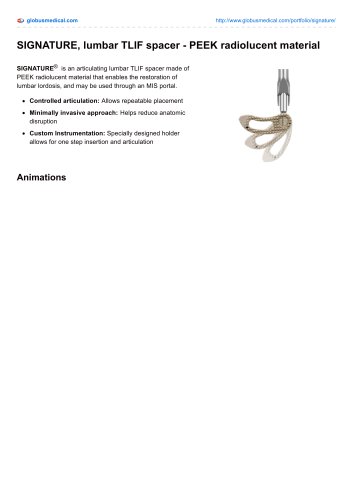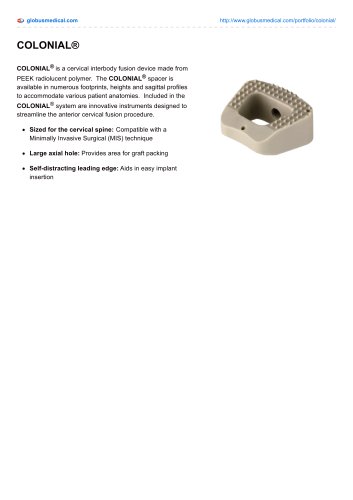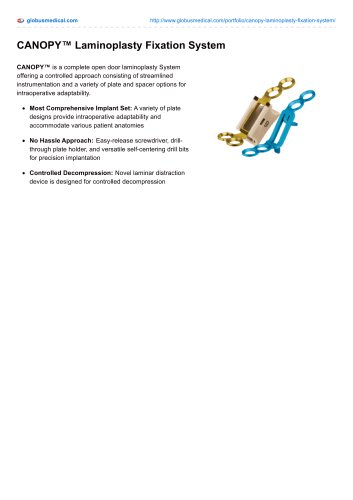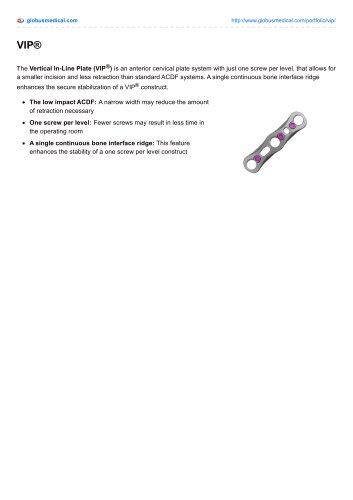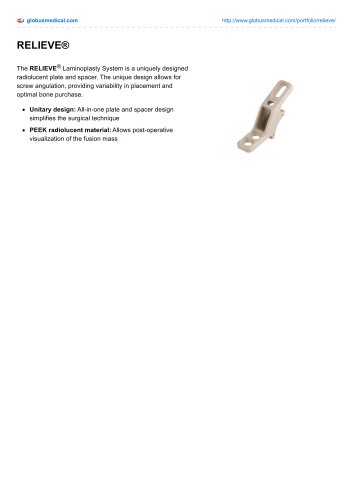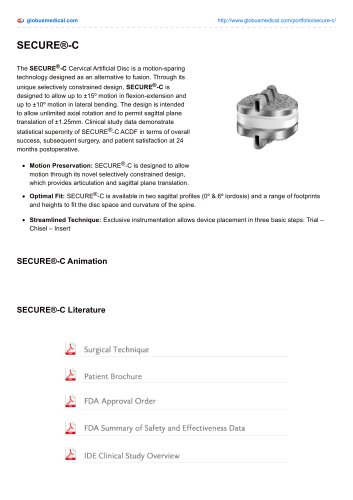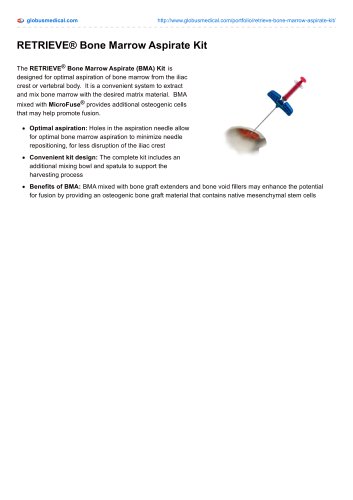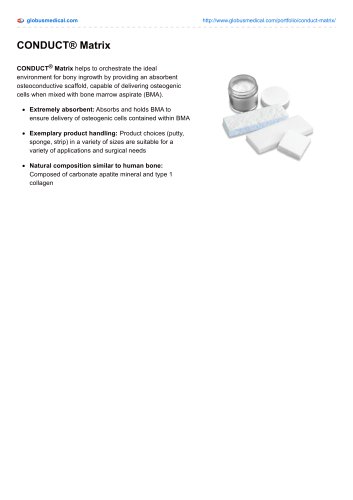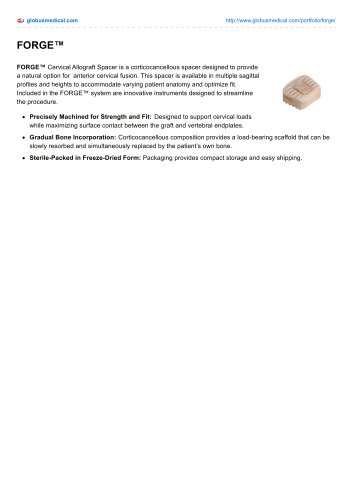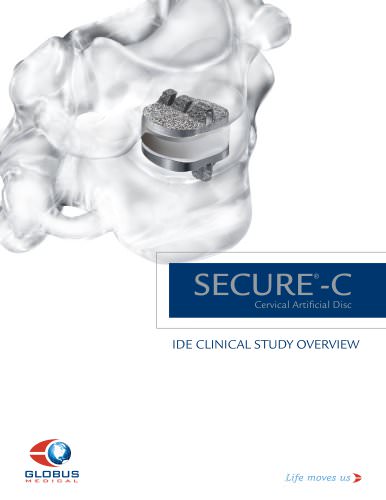 Website:
Globus Medical
Website:
Globus Medical
Catalog excerpts
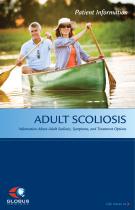
Patient Information ADULT SCOLIOSIS Information About Adult Scoliosis, Symptoms, and Treatment Options
Open the catalog to page 1
Table of Contents Anatomy of the Spine. . . . . . . . . . . . . . . . . . . . . . . . . . . . . . . . . . . . . . . . . . . 2 What is Adult Scoliosis. . . . . . . . . . . . . . . . . . . . . . . . . . . . . . . . . . . . . . . . . . 4 What are the Causes of Adult Scoliosis. . . . . . . . . . . . . . . . . . . . . . . . . . . 5 What are the Symptoms of Adult Scoliosis. . . . . . . . . . . . . . . . . . . . . . . . 6 How is Scoliosis Diagnosed. . . . . . . . . . . . . . . . . . . . . . . . . . . . . . . . . . . . . . 7 General Treatment Options. . . . . . . . . . . . . . . . . . . . . . . . ....
Open the catalog to page 2
Adult Scoliosis Patient Information This brochure will help you understand more about: • Anatomy of the spine • Information about scoliosis • What to expect from surgery The decision to receive medical treatment is individualized to the patient and the patient’s symptoms. The information presented within this brochure may not apply to your condition, treatment or outcome, as surgical techniques vary and complications can occur. It is important to discuss the viability of treatment with your physician to decide which treatment option is right for you. This brochure is intended to be an...
Open the catalog to page 3
Anatomy of the Spine The spine is one of the most important structures in the human body. It supports much of the body’s weight and protects the spinal cord, which carries information from the brain to the rest of the body. The spine is strong yet flexible, allowing for a wide range of movements. To understand scoliosis, you must first understand what a healthy spine looks like. Posterior view (back) Lateral view (side) Anterior view (front) Atlas C1 Axis C2 Atlas C1 Axis C2 Cervical Vertebrae Thoracic Vertebrae Thoracic Curvature Lumbar Vertebrae Lumbar Curvature Adult Scoliosis Patient...
Open the catalog to page 4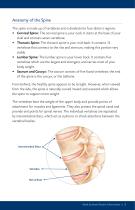
Anatomy of the Spine The spine is made up of vertebrae and is divided into four distinct regions: • ervical Spine: The cervical spine is your neck. It starts at the base of your C skull and contains seven vertebrae. • horacic Spine: The thoracic spine is your mid-back. It contains 12 T vertebrae that connect to the ribs and sternum, making this portion very stable. • Lumbar Spine: The lumbar spine is your lower back. It contains five vertebrae which are the largest and strongest, and carries most of your body weight. • Sacrum and Coccyx: The sacrum consists of five fused vertebrae; the end...
Open the catalog to page 5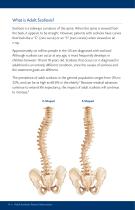
What is Adult Scoliosis? Scoliosis is a sideways curvature of the spine. When the spine is viewed from the back, it appears to be straight. However, patients with scoliosis have curves that look like a “C” (one curve) or an “S” (two curves) when viewed on an x-ray. Approximately six million people in the US are diagnosed with scoliosis.1 Although scoliosis can occur at any age, it most frequently develops in children between 10 and 18 years old. Scoliosis that occurs or is diagnosed in adulthood is an entirely different condition, since the causes of scoliosis and the treatment goals are...
Open the catalog to page 6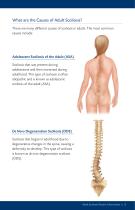
What are the Causes of Adult Scoliosis? There are many different causes of scoliosis in adults. The most common causes include: Adolescent Scoliosis of the Adult (ASA) S coliosis that was present during adolescence and then worsened during adulthood. This type of scoliosis is often idiopathic and is known as adolescent scoliosis of the adult (ASA). De Novo Degeneration Scoliosis (DDS) Scoliosis that began in adulthood due to degenerative changes in the spine, causing a deformity to develop. This type of scoliosis is known as de novo degeneration scoliosis (DDS). Adult Scoliosis Patient...
Open the catalog to page 7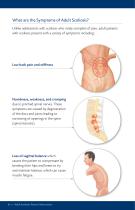
What are the Symptoms of Adult Scoliosis? Unlike adolescents with scoliosis who rarely complain of pain, adult patients with scoliosis present with a variety of symptoms including: Low back pain and stiffness Numbness, weakness, and cramping due to pinched spinal nerves. These symptoms are caused by degeneration of the discs and joints leading to narrowing of openings in the spine (spinal stenosis). L oss of sagittal balance which causes the patient to compensate by bending their hips and knees to try and maintain balance, which can cause muscle fatigue. Adult Scoliosis Patient Information
Open the catalog to page 8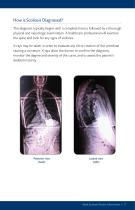
How is Scoliosis Diagnosed? The diagnosis typically begins with a complete history followed by a thorough physical and neurologic examination. A healthcare professional will examine the spine and look for any signs of scoliosis. X-rays may be taken in order to evaluate any tilt or rotation of the vertebrae causing a curvature. X-rays allow the doctor to confirm the diagnosis, monitor the degree and severity of the curve, and to assess the patient’s skeletal maturity. Posterior view (back) Lateral view (side) Adult Scoliosis Patient Information 7
Open the catalog to page 9
General Treatment Options In most cases of adult scoliosis, non-operative treatment is preferred. This can include periodic observation, over-the-counter pain relievers and exercise. Surgical treatment is reserved for patients who have failed all conservative (non-operative) management. The indications for surgery may be based on the following criteria:3 • Back pain that has failed conservative treatment • Progressive leg pain or neurologic deficit • Muscle fatigue secondary to spinal imbalance • Curve progression • Progressive pulmonary compromise secondary to deformity • Severe deformity...
Open the catalog to page 10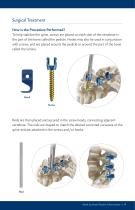
Surgical Treatment How is the Procedure Performed? To help stabilize the spine, screws are placed on each side of the vertebrae in the part of the bone called the pedicle. Hooks may also be used in conjunction with screws, and are placed around the pedicle or around the part of the bone called the lamina. Hook Screw Rods are then placed and secured in the screw heads, connecting adjacent vertebrae. The rods are shaped to match the desired corrected curvature of the spine and are attached to the screws and/or hooks. Adult Scoliosis Patient Information 9
Open the catalog to page 11All Globus Medical catalogs and technical brochures
-
Discover the SHIELD™ VCF System
20 Pages
-
POSTERIOR CERVICAL FUSION
12 Pages
-
ExcelsiusGPS
12 Pages
-
CERVICAL LAMINOPLASTY
14 Pages
-
Discover the AFFIRM™ VCF System
20 Pages
-
SECURE-C®
24 Pages
-
ACDF
16 Pages
-
TLIF patient brochure
12 Pages
-
SI-LOK™
12 Pages
-
TRANSITION
12 Pages
-
complete bone graft
1 Pages
-
SP-Fix
12 Pages
-
SECURE®-C
24 Pages
-
Adolescent Idiopathic Scoliosis
16 Pages
-
MIS LLIF
16 Pages
-
MIS TLIF
12 Pages
-
MONUMENT
2 Pages
-
CREO AMP® Threaded
1 Pages
-
CREO MCS?
2 Pages
-
SHIELD?
1 Pages
-
ACADIA®
1 Pages
-
SIGNATURE®
1 Pages
-
SUSTAIN® & SUSTAIN®-R, Arch
1 Pages
-
TRUSS®
1 Pages
-
XPand®-R
1 Pages
-
ZYFUSE®
1 Pages
-
COLONIAL®
1 Pages
-
VIP®
1 Pages
-
PROVIDENCE?
1 Pages
-
RELIEVE®
1 Pages
-
ASSURE®
1 Pages
-
SECURE®-C
2 Pages
-
COALITION®
1 Pages
-
CAPITOL?
1 Pages
-
LATIS
3 Pages
-
CONDUCT® Matrix
1 Pages
-
FORGE?
1 Pages
-
SECURE®-C technical overview
12 Pages

